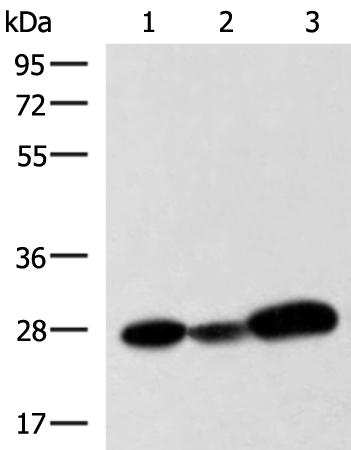VEGFA Polyclonal Antibody
For reference only. Please follow the manual included in your kit for instructions.
Catalog Number
RD219306A
Product Name
VEGFA Polyclonal Antibody
Catalog Number
RD219306A
Clonality
Polyclonal
Purification Method
Antigen affinity purification
Isotype
IgG
Host
Rabbit
Background
This gene is a member of the PDGF/VEGF growth factor family. It encodes a heparin-binding protein, which exists as a disulfide-linked homodimer. This growth factor induces proliferation and migration of vascular endothelial cells, and is essential for both physiological and pathological angiogenesis. Disruption of this gene in mice resulted in abnormal embryonic blood vessel formation. This gene is upregulated in many known tumors and its expression is correlated with tumor stage and progression. Elevated levels of this protein are found in patients with POEMS syndrome, also known as Crow-Fukase syndrome. Allelic variants of this gene have been associated with microvascular complications of diabetes 1 (MVCD1) and atherosclerosis. Alternatively spliced transcript variants encoding different isoforms have been described. There is also evidence for alternative translation initiation from upstream non-AUG (CUG) codons resulting in additional isoforms. A recent study showed that a C-terminally extended isoform is produced by use of an alternative in-frame translation termination codon via a stop codon readthrough mechanism, and that this isoform is antiangiogenic. Expression of some isoforms derived from the AUG start codon is regulated by a small upstream open reading frame, which is located within an internal ribosome entry site.
Immunogen Information
Immunogen
Synthetic peptide of human VEGFA
Swissprot
P15692
Synonyms
Folliculostellate cell-derived growth factorGlioma-derived endothelial cell mitogenMGC70609MVCD1Vascular endothelial growth factor Avascular endothelial growth factor A121vascular endothelial growth factor A165vascular endothelial growth factorVas
Calculated MW
27 kDa
Observed MW
Refer to figures
Gene Accession
NP001020537
Applications
Reactivity
Human
Tested Applications
WB,IHC,ELISA
Conjugation
Unconjugated
Dilution
WB 1:1000-1:5000, IHC 1:25-1:100, ELISA 1:5000-1:10000
Concentration
1.32 mg/mL
Storage Buffer
PBS with 0.05% NaN3 and 40% Glycerol, pH7.4
Storage Instructions
Store at -20°C. Avoid freeze / thaw cycles.


